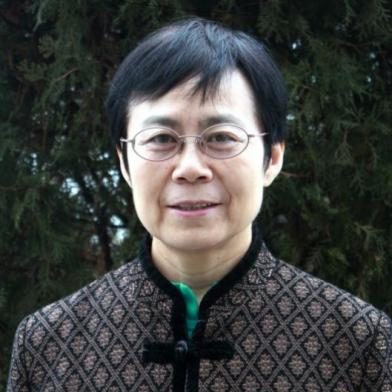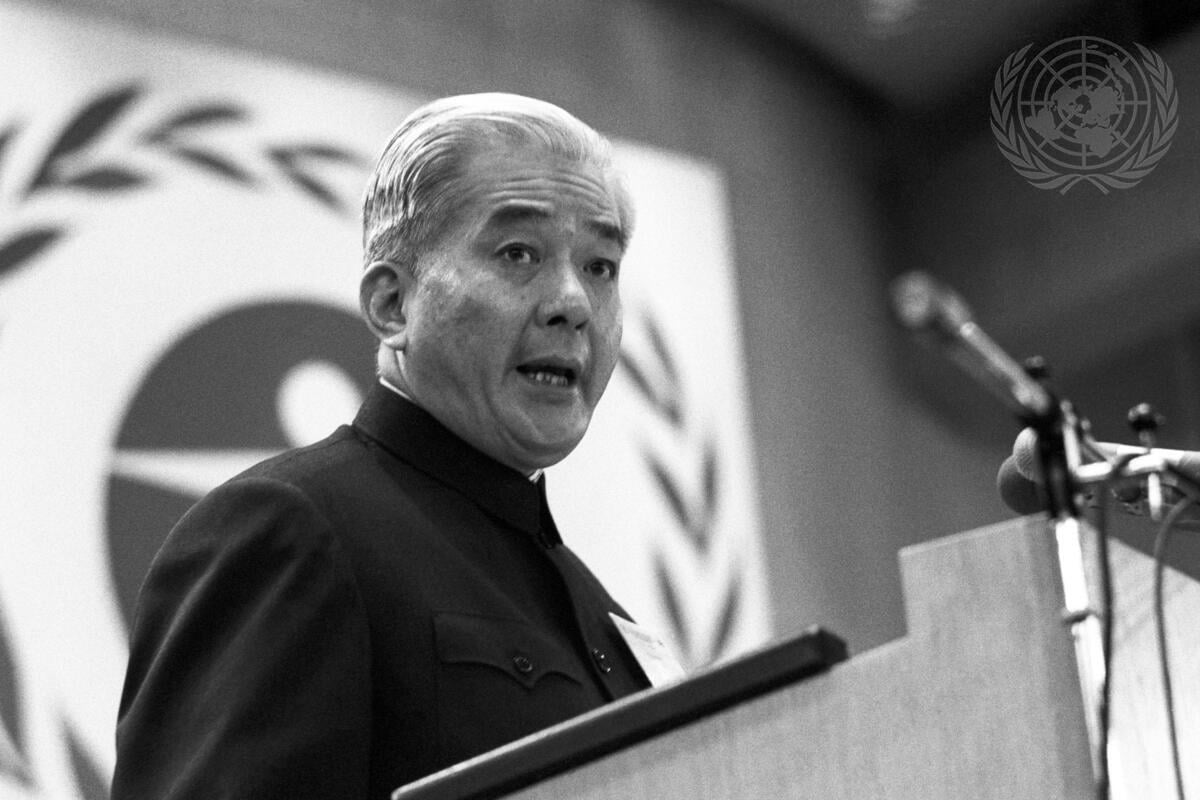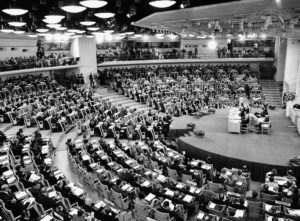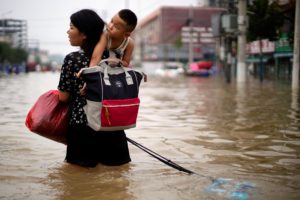Next month, China is set to host a major UN environmental conference, after a delay of more than a year due to Covid-19. The 15th Conference of the Parties to the UN Convention on Biological Diversity (CBD COP15), to be held in Kunming from Oct 11-15, will not be the first UN environmental talks hosted by China. But since COP15 has the mission of reaching a global agreement on biodiversity protection for the next decade, China’s presidency carries a particular weight, as countries look for effective leadership to move the negotiations forward.
Just 50 years ago, in October 1971, China was a “new face” at the United Nations, being seated as a permanent member by a vote at the General Assembly. Since then the country has grown into an indispensable stakeholder in global environmental governance. Its participation in international processes has also influenced China’s thinking about its own environmental protection.
The 1972 UN Conference on the Human Environment, held in Stockholm from 5 to 16 June, was the first major UN environmental event that China participated in as a permanent member. It was also the starting point for China to critically look at global environmental issues. The conference, happening at a time of heightened Cold War tensions, for the first time presented to China’s leaders the challenges of environment and development, environment and ideology, environment and future generations. It spurred them to look at China’s own emerging environmental problems when the country was still mired in Cultural Revolution chaos. The seed of post-Cultural Revolution environmental efforts was planted then and there.

As the 50th anniversary of the Stockholm Conference draws nearer, China Dialogue interviewed Dr Li Lailai, former Deputy Director and Asia Centre Director of the Stockholm Environment Institute and former Director of the World Resources Institute’s China office. As part of her research for a book project, Dr Li went through archival materials from the conference and interviewed its participants both in China and in Sweden. Among her interviewees was Qu Geping, member of the 1972 Chinese delegation and “father of environmental protection in China.” Dr Li shared with us the unique historical context of the conference, China’s role in it and its impact on China’s environmental trajectory.
Qu Geping is one of the founders and principal figures of modern China’s environmental protection system.
He was the first director of China’s environmental protection bureau and its first representative at the UN Environment Programme in Nairobi, Kenya.
He led the development of China’s first batch of environmental laws and regulation. And he was a member of the Chinese delegation at the 1972 UN Conference on the Human Environment.
China Dialogue: The world of 1972 was deeply divided by an intensifying Cold War. Why did the UN choose to convene an environmental conference at that time?
Li Lailai: In the 1960s, the Western and Soviet camps were at odds with each other on almost everything. The United Nations at that time was focused on nuclear weapons and the peaceful utilisation of nuclear energy. In 1967, Swedish diplomats Inga Thorsson and others made a proposal for the UN to convene a conference on the human environment with the intention to broaden the UN’s focus area and ameliorate Cold War tensions through the environment, a relatively scientific topic, allowing more member states to be on board.
Sweden was not a NATO member at that time and considered its relatively neutral position an advantage in making such a proposal. It was also experiencing an environmental awakening in the face of serious pollution problems. Its geographical location and the patterns of atmospheric and oceanic circulations made its environment particularly vulnerable. These factors prompted Sweden to propose the Stockholm Conference.

What were some of the challenges in preparing the conference? And what role did China play?
Getting the developing countries on board was one of the biggest challenges for the organisers. Much of the Third World at the time had barely emerged from colonialism. Poverty, hunger and recovery from the terrors of war were pressing issues. Many developing countries did not feel that environmental protection was something they should be concerned with. Countries such as Brazil declared the conference a “game of the rich” and Yugoslavia suggested that it might boycott it. China did not play much of a role in the preparation phase as it did not become a member of the UN until October 1971.
One development made the organisers particularly anxious. The Soviet Union, previously in support of holding the conference, turned against it after the UN refused to accept East Germany as a participant. The whole Warsaw Pact decided to boycott the conference afterwards. The UN’s decision to hold the conference was initially made possible by a consensus reached between the US and Soviet Union. Now the turn of events could have triggered a chain reaction where developing nations, unfazed by the subject matter in the first place, chose not to bother with participation. For the organisers, having India and China, the two major developing countries on board became critical for the success of the conference.
Having India and China on board became critical for the success of the conference
In the end, 113 countries sent delegations to the conference, many of them “Third World”countries from Asia, Africa and Latin America. How did the organisers manage to get them on board?
The Secretary-General of the conference, Maurice Strong of Canada, was a man of great leadership. From the start he realised that environment and development was a crucial issue. Having a candid conversation about it was a prerequisite for developing country participation. In 1971, he suggested the UN convene a seminar in Founex, Switzerland, inviting 27 top experts on environment and development to discuss the topic. The seminar produced the important Founex Report which systematically outlined the developmental challenges faced by developing countries at the time. It pointed out that developing countries were not confronting the threats to their “quality of life”. Life itself was endangered in those countries.
In a way, the Founex Report was a precursor to what India’s Prime Minister Indira Gandhi said at the Stockholm Conference itself: Poverty is the greatest polluter. It set the parameters for discussions on environment and development, and laid the foundation for engagement with developing countries. After the Founex Report, Strong went on a tour of numerous developing countries. He visited India and persuaded Prime Minister Gandhi to personally attend as head of the Indian delegation. He then landed in China and met with then Vice Minister of Foreign Affairs Qiao Guanhua. The invitation was ultimately passed upward to the table of Premier Zhou Enlai, who was convinced China should participate.
The invitation arrived at the time of the Cultural Revolution. How did China view the conference, and its own environmental problems, then?
According to Qu Geping’s recollections, most people involved in China’s preparation for the conference approached it as a forum of “international class struggle”. They saw environmental problems as the exclusive ills of capitalist societies. But Zhou Enlai made interventions in the process and pointed out that China should acknowledge its own environmental problems and use the conference as an opportunity to reflect on such issues and study the good practices of other nations.
Zhou also realised that although pollution of the environment brought harm to human health, it was not merely an issue of public health and hygiene. It touched upon all aspects of the national economy. The original plan to have the Ministry of Health lead the Chinese delegation was vetoed by Zhou, who instructed the Ministry of Fuel and Chemicals and the National Commission for Planning to put together a delegation. In the end, the Chinese delegation hailed from multiple ministries and departments, led by Tang Ke, Vice Minister of Fuel and Chemicals, and Gu Ming, Deputy Director of the National Commission for Planning. Qu Geping and Bi Jilong, then colleagues at the State Council Group for Plan Drafting, were also enlisted into the 40-member delegation.
How did the conference’s proceedings and outcomes reflect all the preparatory work that had gone into it?
The conference’s most important outcome, The Declaration on the Human Environment (Stockholm Declaration), listed 26 principles, many of which addressed the issue of development. It maintains that environmental problems in developing countries should be tackled through development. But development does not equate simply to economic growth. Other social and environmental dimensions should be incorporated.
Another important outcome was the recognition of international cooperation in environmental protection, and the establishment of responsibility for developed countries to support developing countries in addressing their environmental challenges.
In anticipation of some of the outcomes that favoured the developing world, a few developed nations tried to covertly intervene through a secret, informal faction later known as the “Brussels group.” Their main objective was to prevent the new global environmental consensus from disrupting global trade and dissuade the UN from allocating a high budget for its newly established agency, the UN Environment Programme, as it would become a financial burden for rich member states. These concerns from the global north also found their way into the final outcomes.
What role did China play during the conference?
Passing the Stockholm Declaration and the Action Plan for the Human Environment was crucial for the success of the conference.
The declaration was almost finalised before the conference kicked off, as nations had negotiated the text in pre-meetings. Only one day was left at the conference to discuss it. However, China’s absence in almost all the pre-meetings meant that it had zero involvement in the creation of a crucial declaration that it needed to sign. Therefore, the Chinese delegation asked for a re-opening of negotiations on the text. They presented the case as a “struggle between control and counter-control”. This certainly brought some difficulties to the proceedings of the conference. But in the end an agreement was made.
If you look at the final declaration, you will find a few quotations from Chairman Mao, such as “Of all things in the world, people are the most precious” and “Man has constantly to sum up experience, and go on discovering, inventing, creating and advancing.” These are actually the Chinese delegation’s response to parts of the draft text they felt suggested that rapid population growth was to blame for poverty and environmental degradation.
Sweden, as the president, and Maurice Strong, as the secretary-general, both played very constructive roles in engaging the Chinese delegation, providing them with daily updates on key discussions at the conference.
Unlike the Stockholm Declaration, the Action Plan for the Human Environment was very detailed and technical, containing 109 action points. After seeing China re-open the negotiation on the declaration, some countries entertained the idea of re-negotiating the action plan, too. If that had happened, the conference would have ended in failure with countries unable to conclude the negotiations on time. China was pragmatic with its asks. While it called for the re-opening of the declaration text, it did not propose to re-negotiate the action plan. According to some conference attendees, that position helped the conference reach a timely, successful conclusion.
After the conference, Beijing held China’s first national environmental conference in 1973, still amid the Cultural Revolution. China’s domestic environmental journey started there. How has the Stockholm Conference shaped that journey?
The conference invited every country to submit a report on its environmental issues. When Maurice Strong met with Qiao Guanhua, he proposed that China could use the report to introduce its experience in waste recycling to the world. At that time, China already had some good practices with waste recycling. So what China presented was essentially its experience in environmental management. The final action plan also contained sections on environmental management. Poor management led to environmental problems, that was the message.
Ten years later, after the country emerged from the Cultural Revolution, China’s second national environmental protection conference in 1983 made strengthening environmental management a key issue. The reason for such a focus was that China at that time was still under-developed and lacked advanced technologies to copy the Western approach of technology-based pollution treatment. It had to achieve its environmental goals through better management. This was the legacy of the Stockholm Conference in China.
The conference’s upholding of international cooperation in global environmental affairs (Principle 24) also has a lasting impact. During the intense Cold War years, the US and Soviet Union found in environmental affairs a low-risk area for cooperation. It paved the way for the recognition of international cooperation in this arena.
For China, after the country’s environmental protection work started to pick up speed in the 1980s [with the establishment of a dedicated environmental agency and new environmental laws created], the China Council for the International Cooperation on Environment and Development (CCICED) was established following Qu Geping’s suggestion. China was among the first countries to systematically and proactively start to advance international environmental cooperation. Many other countries also invoked Principle 24 as a basis for advocating more cooperation.
The Stockholm Conference also set the precedent for NGO participation in UN environmental processes. From then on, at every UN environmental conference and COP, the active presence of NGOs became a normal sight for both Chinese and other delegations.
Read more from China Dialogue’s Environmental History Series.









